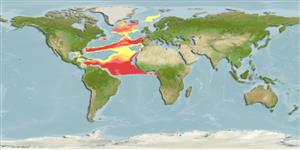>
Lophiiformes (Anglerfishes) >
Gigantactinidae (Whipnose anglers)
Etymology: Gigantactis: Greek, 'gigas' or 'gigantos' = gigantic + Greek, 'aktis' = ray (referring to the unusually long first dorsal-fin spine that functions as a lure in this genus) (Ref. 86949).
More on author: Regan.
Environment: milieu / climate zone / depth range / distribution range
Ekologi
laut batipelagis; kisaran kedalaman 2000 - 2500 m (Ref. 86949). Deep-water
Atlantic Ocean: in tropical waters.
Size / Weight / umur
Maturity: Lm ? range ? - ? cm
Max length : 10.7 cm TL jantan/; (Ref. 44404)
deskripsi pendek
Kunci identifiaksi (pengenalan) | Morfologi | Morfometrik
duri punggung lunak (Keseluruhan (total)) : 5 - 6; Sirip dubur lunak: 5 - 6. Metamorphosed females distinguished by the following characteristics: length of illicium less than 120% SL (104-107%SL); escal bulb with an elongate darkly pigmented spinulose distal prolongation; presence of short distal and slender proximal escal filaments; absence of distally flattened escal papillae; illicium without posterior pair of papillae; dentary teeth in posterior part of jaw in three longitudinal series; rays of caudal fin less than 30% SL (Ref. 86949).
Life cycle and mating behavior
Maturities | Reproduksi, perkembang biakan | Spawnings | Egg(s) | Fecundities | Larva
Bertelsen, E., 1990. Gigantactinidae. p. 513-515. In J. C. Quero, J. C. Hureau, C. Karrer, A. Post and L. Saldanha (eds.) Check-list of the fishes of the eastern tropical Atlantic (CLOFETA). JNICT, Lisbon; SEI, Paris; and UNESCO, Paris. Vol. 1. (Ref. 10761)
Status IUCN Red List (Ref. 130435)
ancaman kepada manusia
Harmless
penggunaan manusia
Alat, peralatan
laporan khas
muat turun XML
Sumber internet
Estimates based on models
Preferred temperature (Ref.
123201): 3.2 - 4.2, mean 3.6 °C (based on 93 cells).
Phylogenetic diversity index (Ref.
82804): PD
50 = 0.5000 [Uniqueness, from 0.5 = low to 2.0 = high].
Bayesian length-weight: a=0.01000 (0.00244 - 0.04107), b=3.04 (2.81 - 3.27), in cm total length, based on all LWR estimates for this body shape (Ref.
93245).
Trophic level (Ref.
69278): 3.7 ±0.6 se; based on size and trophs of closest relatives
Fishing Vulnerability (Ref.
59153): Low vulnerability (10 of 100).
